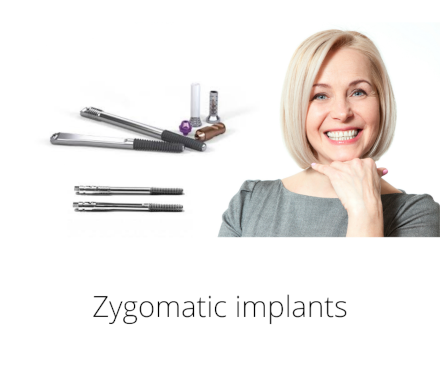
Zygomatic implants is a procedure used to rehabilitate only the upper jaw and it used as a last resort when other methods are no longer applicable to solve the edentulism issue.
There are various treatments for dental implant rehabilitation. The treatment and type of implant depend on each individual case and bone density. This implant is suitable for very specific cases in which the maxillary bone is practically non-existent.
This procedure was discovered by Branemarck at the same time as immediate loading implants in 1990. He changed implantology with this innovation and also gave hope to those for whom a fixed rehabilitation was considered impossible.
Who are the candidates for zygomatic implants?
- Patients who are toothless in the upper jaw. People who suffered from gum diseases or advanced periodontitis, which caused bone damage and due to bone deficiency cannot use other conventional implants.
- People who used removable prostheses for many years. The pressure caused by these prostheses may lead to bone reabsorption. This reabsorption can be so severe that the only rehabilitation option is zygomatic implantology.
- Adults that present severe maxillary atrophy. Children that cannot have a surgical procedure because their facial structure is still developing.
- People who suffered severe traumas due to an accident or had surgery to remove bone due to tumour issues.
- Patients with congenital anomalies in which the bone structure does not allow conventional implant insertion.
What are the procedures for zygomatic implant treatments?
- The patient will be evaluated by a dentist. Three-dimensional x-rays such as CAT scans will be analysed and study models will be made to plan the prosthetic stage.
- This type of surgery requires general anaesthesia and an anaesthetist. Greater responsibility and experience from the health professional is required. Not every dentist is qualified to perform this procedure. These professionals should have intensive and specific training.
- This surgery includes a small cut in the gum to find the bone where the zygomatic implants will be placed. These implants have greater dimensions in comparison with the conventional ones, around 30 to 50 mm, and are fixed on the face bone or cheekbone, which is known as a zygomatic bone. Later, dental prostheses will be placed over them.
Advantages of Zygomatic Implants
- They are an excellent alternative to those who do not have bone and want to rehabilitate their upper jaw.
- It is a good alternative for patients who suffered from chronic periodontitis with lost teeth and bone structure in the upper jaw.
- The insertion of this implant in the zygomatic bone provides great stability for the fixed prosthesis. The prosthesis can be fixed in this type of implant. It is functional and enables the chewing of hard foods.
- Studies have shown that this type of implant is safe and has a long life.
- The postoperative stage is simple, fast, and without complications.
- It enables the restoration of teeth for people without maxillary bone structure in cases once considered impossible.
- The prosthesis is fixed, using the immediate loading system without intermediary and provisory prostheses. In other words, a toothless person enters the clinic and hours later will leave with all the missing teeth fixed on long implants that are called zygomatic.
Vita Center Medical Reference- Reviewed by VitaCentre Dental Clinic Staff on March 7, 2022

